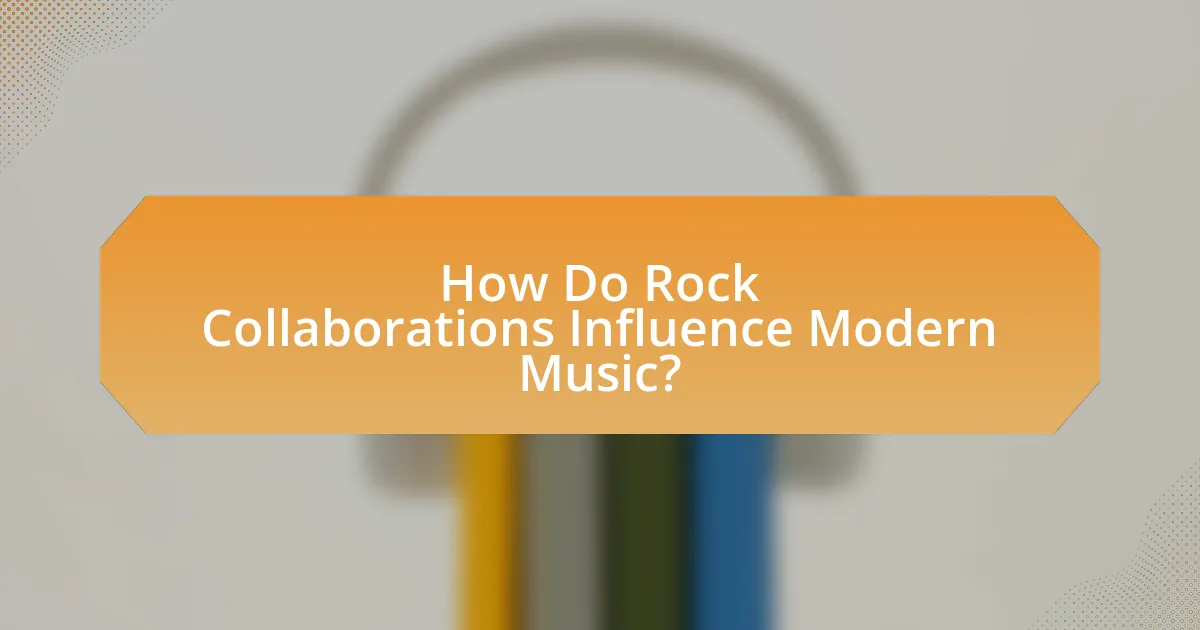Rock collaborations are musical partnerships between artists from different bands or genres that create unique songs or albums, significantly influencing the rock music landscape. This article explores the importance of these collaborations, highlighting iconic duos such as Mick Jagger and Keith Richards, and John Lennon and Paul McCartney, who have shaped the genre through their innovative sounds and memorable hits. It examines the defining characteristics of successful collaborations, the impact of cultural shifts, and the role of technology and social media in modern music partnerships. Additionally, it discusses best practices for aspiring musicians and common pitfalls to avoid in collaborative efforts, providing insights into how these partnerships can lead to groundbreaking music.

What are Rock Collaborations and Why Do They Matter?
Rock collaborations are musical partnerships between artists, often from different bands or genres, that create unique songs or albums. These collaborations matter because they blend diverse influences, resulting in innovative sounds and expanding the creative boundaries of rock music. For example, the collaboration between Aerosmith and Run-D.M.C. on “Walk This Way” in 1986 fused rock and hip-hop, leading to a resurgence in popularity for both genres and influencing future collaborations. Such partnerships not only enhance artistic expression but also attract wider audiences, demonstrating the power of collaboration in the music industry.
How have iconic duos shaped the rock music landscape?
Iconic duos have significantly shaped the rock music landscape by creating influential sounds and memorable hits that resonate with audiences. For instance, the partnership of Mick Jagger and Keith Richards of The Rolling Stones produced timeless classics like “Paint It Black” and “Sympathy for the Devil,” which not only defined the band’s identity but also influenced countless artists across genres. Similarly, the collaboration between John Lennon and Paul McCartney of The Beatles revolutionized songwriting and music production, leading to innovative albums such as “Sgt. Pepper’s Lonely Hearts Club Band,” which is often cited as one of the greatest albums of all time. These duos exemplify how collaborative creativity can lead to groundbreaking music that shapes cultural movements and inspires future generations of musicians.
What are some defining characteristics of successful rock collaborations?
Successful rock collaborations are characterized by complementary musical styles, strong chemistry between artists, and a shared vision for the project. Complementary musical styles allow artists to blend their unique sounds, enhancing creativity and innovation, as seen in collaborations like “Under Pressure” by Queen and David Bowie. Strong chemistry fosters effective communication and collaboration, which is evident in the partnership between Mick Jagger and David Bowie, where their dynamic interplay resulted in memorable performances. A shared vision ensures that all parties are aligned on the artistic direction, exemplified by the collaboration between Eric Clapton and B.B. King, which produced the critically acclaimed album “Riding with the King.” These characteristics contribute to the overall success and impact of rock collaborations.
How do collaborations influence the creative process in rock music?
Collaborations significantly enhance the creative process in rock music by merging diverse musical influences and ideas from different artists. This blending of styles often leads to innovative sounds and unique compositions, as seen in iconic partnerships like that of Freddie Mercury and David Bowie on “Under Pressure,” which combined their distinct vocal styles and songwriting approaches. Such collaborations can also foster a dynamic exchange of creativity, allowing artists to push their boundaries and explore new artistic directions, ultimately enriching the rock genre as a whole.
What are the historical contexts of notable rock collaborations?
Notable rock collaborations often emerged during periods of cultural and musical evolution, reflecting the social and political climates of their times. For instance, the collaboration between David Bowie and Queen on “Under Pressure” in 1981 was influenced by the rising tensions of the Cold War and the need for unity in a divided world. Similarly, the partnership of Aerosmith and Run-D.M.C. on “Walk This Way” in 1986 marked a significant moment in the crossover between rock and hip-hop, showcasing the growing acceptance of diverse musical genres during the 1980s. These collaborations not only highlighted the artists’ individual talents but also served as a response to the changing landscape of music and society, illustrating how historical contexts shaped their creative outputs.
Which collaborations emerged during pivotal moments in rock history?
Collaborations that emerged during pivotal moments in rock history include the partnership between David Bowie and Mick Jagger on the 1985 single “Dancing in the Street,” which symbolized a unifying moment in music during a time of social change. Another significant collaboration was the supergroup Cream, formed in 1966 by Eric Clapton, Jack Bruce, and Ginger Baker, which played a crucial role in the development of blues rock. Additionally, the collaboration between Aerosmith and Run-D.M.C. on “Walk This Way” in 1986 bridged the gap between rock and hip-hop, marking a transformative moment in both genres. These collaborations not only showcased the artists’ talents but also reflected and influenced the cultural landscape of their respective eras.
How did cultural shifts impact the nature of rock collaborations?
Cultural shifts significantly transformed rock collaborations by fostering diversity and experimentation among artists. The rise of counterculture movements in the 1960s and 1970s encouraged collaborations that blended genres, leading to iconic partnerships like that of David Bowie and Mick Jagger, which showcased the merging of rock with pop and soul influences. Additionally, the advent of technology and the internet in the late 20th century facilitated remote collaborations, allowing artists from different backgrounds and locations to work together, exemplified by projects like the Gorillaz, which featured a wide array of guest musicians across various styles. These cultural changes not only expanded the sonic possibilities within rock music but also reflected broader societal trends towards inclusivity and innovation.
![]()
Who are Some of the Most Iconic Rock Duos?
Some of the most iconic rock duos include Simon & Garfunkel, consisting of Paul Simon and Art Garfunkel, known for their harmonious vocals and hits like “The Sound of Silence.” Another notable duo is The White Stripes, featuring Jack White and Meg White, recognized for their raw sound and influential albums such as “Elephant.” Additionally, the partnership of John Lennon and Paul McCartney from The Beatles is legendary, producing timeless classics like “Hey Jude” and “Let It Be.” These duos have significantly shaped rock music history through their unique collaborations and memorable songs.
What makes a duo iconic in the rock genre?
A duo becomes iconic in the rock genre through their unique musical synergy, distinctive sound, and cultural impact. For instance, the partnership of Mick Jagger and Keith Richards of The Rolling Stones exemplifies this, as their collaboration produced timeless hits and defined rock music’s rebellious spirit. Additionally, the emotional connection and chemistry between the duo often resonate with audiences, creating a lasting legacy. The success of iconic duos can also be measured by their influence on subsequent artists and their ability to innovate within the genre, as seen with the partnership of John Lennon and Paul McCartney, whose songwriting transformed popular music.
Which duos have had the most significant impact on rock music?
The duos that have had the most significant impact on rock music include John Lennon and Paul McCartney, and Mick Jagger and Keith Richards. John Lennon and Paul McCartney, as members of The Beatles, revolutionized rock music in the 1960s with their innovative songwriting and harmonies, leading to the band’s unprecedented global influence and commercial success, including 20 number-one hits on the Billboard Hot 100. Mick Jagger and Keith Richards, as the core of The Rolling Stones, have shaped rock’s rebellious image and sound since the 1960s, with their partnership resulting in iconic albums like “Let It Bleed” and “Exile on Main St.,” which have been critically acclaimed and commercially successful, solidifying their legacy in rock history.
How do the dynamics between duo members contribute to their success?
The dynamics between duo members significantly contribute to their success by fostering complementary skills and enhancing creative synergy. For instance, in iconic rock duos like Lennon and McCartney, their contrasting songwriting styles—Lennon’s introspective lyrics paired with McCartney’s melodic sensibilities—allowed them to create a diverse range of music that appealed to a broad audience. This synergy is supported by research from the Journal of Creative Behavior, which indicates that collaboration between individuals with different strengths leads to more innovative outcomes. Thus, the interplay of their unique talents and perspectives not only drives creativity but also solidifies their place in music history.
What are some memorable collaborations between rock legends?
Some memorable collaborations between rock legends include “Under Pressure” by Queen and David Bowie, which became a defining anthem in 1981, showcasing the unique blend of their vocal styles. Another significant collaboration is “Walk This Way” by Aerosmith and Run-D.M.C., released in 1986, which successfully bridged rock and hip-hop, revitalizing Aerosmith’s career. Additionally, “The Last DJ” by Tom Petty and the Heartbreakers features contributions from various rock icons, emphasizing the collective spirit of rock music. These collaborations not only produced chart-topping hits but also left a lasting impact on the music industry, demonstrating the power of artistic synergy among rock legends.
How did these collaborations come to fruition?
These collaborations came to fruition through a combination of mutual respect among artists, shared musical vision, and strategic networking within the music industry. For instance, iconic duos often emerged from artists who admired each other’s work and sought to blend their unique styles, leading to innovative musical creations. Additionally, record labels and producers played a crucial role by facilitating introductions and providing the necessary resources for collaboration, as seen in the partnerships formed during the 1970s and 1980s, which were marked by significant cross-genre experimentation.
What are the standout tracks from these iconic partnerships?
Standout tracks from iconic rock partnerships include “Under Pressure” by Queen and David Bowie, which showcases a unique blend of their distinct styles and became a defining anthem of the 1980s. Another notable collaboration is “Walk This Way” by Aerosmith and Run-D.M.C., which successfully merged rock and hip-hop, revitalizing Aerosmith’s career and influencing future genres. Additionally, “The Girl Is Mine” by Michael Jackson and Paul McCartney highlights their vocal harmonies and was a commercial success, reaching number two on the Billboard Hot 100. These tracks exemplify the creative synergy and cultural impact of their respective partnerships.

How Do Rock Collaborations Influence Modern Music?
Rock collaborations significantly influence modern music by blending diverse styles and expanding audience reach. Collaborations between rock artists and musicians from other genres, such as hip-hop or pop, create innovative sounds that attract new listeners. For instance, the collaboration between Aerosmith and Run-D.M.C. on “Walk This Way” in 1986 not only revitalized Aerosmith’s career but also bridged rock and hip-hop, leading to a surge in cross-genre collaborations. Additionally, modern platforms like streaming services facilitate these partnerships, allowing artists to experiment and reach global audiences, further shaping contemporary music trends.
What trends in rock collaborations are emerging today?
Emerging trends in rock collaborations today include genre-blending partnerships, increased use of technology for remote collaboration, and a focus on social and political themes. Artists are increasingly collaborating across genres, such as rock with hip-hop or electronic music, to reach broader audiences and create innovative sounds. The COVID-19 pandemic accelerated remote collaborations, allowing musicians to work together from different locations using digital tools. Additionally, many rock collaborations now address contemporary social issues, reflecting the artists’ desire to engage with their audience on pressing topics. These trends are evident in recent projects by artists like Dave Grohl and various hip-hop artists, showcasing the evolving landscape of rock music.
How are new technologies shaping collaborative efforts in rock music?
New technologies are significantly enhancing collaborative efforts in rock music by facilitating remote collaboration and streamlining the production process. Digital audio workstations (DAWs) allow musicians to record, edit, and mix tracks from different locations, enabling artists to work together without geographical constraints. For instance, platforms like Splice and Soundtrap provide cloud-based environments where musicians can share and collaborate on projects in real-time. Additionally, advancements in communication tools, such as video conferencing and instant messaging, enable artists to discuss ideas and provide feedback instantly, fostering a more dynamic creative process. These technological innovations have led to increased collaboration among artists, resulting in diverse and innovative rock music projects that reflect a blend of styles and influences.
What role do social media and streaming platforms play in modern collaborations?
Social media and streaming platforms are crucial in facilitating modern collaborations by providing artists with tools for promotion, communication, and audience engagement. These platforms enable musicians to connect directly with fans and other artists, fostering collaborative opportunities that may not have existed previously. For instance, platforms like Instagram and TikTok allow artists to share snippets of their work, garner feedback, and even collaborate in real-time, which can lead to spontaneous partnerships. Additionally, streaming services such as Spotify and Apple Music offer features that promote collaborative playlists and highlight new releases, increasing visibility for joint projects. The rise of these digital platforms has transformed the landscape of music collaboration, making it more accessible and immediate, as evidenced by the surge in cross-genre collaborations that have gained popularity in recent years.
What lessons can be learned from successful rock collaborations?
Successful rock collaborations demonstrate the importance of blending diverse musical styles and talents to create innovative soundscapes. For instance, the collaboration between Aerosmith and Run-D.M.C. on “Walk This Way” merged rock and hip-hop, leading to a resurgence in popularity for both genres and showcasing how cross-genre partnerships can expand audience reach. Additionally, these collaborations often highlight the significance of mutual respect and creative freedom among artists, as seen in the partnership between David Bowie and Queen on “Under Pressure,” which resulted in a timeless classic that benefited from the unique contributions of both parties. Ultimately, successful rock collaborations teach that embracing diversity and fostering collaboration can lead to groundbreaking music that resonates with a wide audience.
How can aspiring musicians apply these lessons to their own collaborations?
Aspiring musicians can apply the lessons from iconic rock collaborations by prioritizing open communication and mutual respect in their partnerships. Effective collaboration often hinges on the ability to share ideas freely and constructively, as demonstrated by successful duos like Lennon and McCartney, who thrived on their ability to challenge each other while maintaining a strong friendship. Additionally, aspiring musicians should embrace diverse influences and styles, as seen in collaborations that blend genres, which can lead to innovative soundscapes and broaden their artistic horizons. By studying the dynamics of these iconic partnerships, musicians can learn the importance of balancing individual creativity with collective goals, ultimately enhancing their collaborative efforts.
What are some common pitfalls to avoid in rock collaborations?
Common pitfalls to avoid in rock collaborations include poor communication, lack of clear roles, and creative differences. Poor communication can lead to misunderstandings and conflict, which can derail the collaborative process. A lack of clear roles may result in overlapping responsibilities or confusion about decision-making, hindering productivity. Creative differences, if not managed properly, can create tension and prevent the collaboration from reaching its full potential. Historical examples, such as the tensions between members of Fleetwood Mac during the recording of “Rumours,” illustrate how these pitfalls can impact the outcome of a collaboration.
What are the best practices for creating successful rock collaborations?
The best practices for creating successful rock collaborations include clear communication, mutual respect, and a shared vision for the project. Clear communication ensures that all parties understand their roles and contributions, which is essential for cohesive teamwork. Mutual respect fosters a positive working environment, allowing artists to express their creativity without fear of judgment. A shared vision aligns the collaborators’ goals, ensuring that the final product reflects the strengths and styles of all involved. Historical examples, such as the collaboration between Aerosmith and Run-D.M.C. on “Walk This Way,” demonstrate how these practices can lead to innovative and commercially successful outcomes, as the fusion of rock and hip-hop attracted diverse audiences and revitalized both genres.


